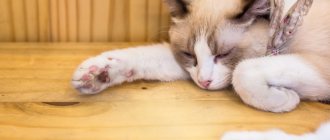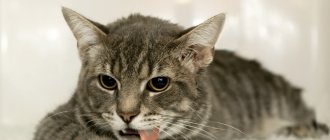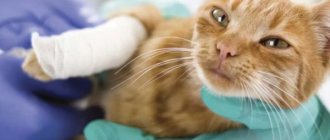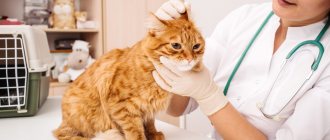Reasons why a cat's hind legs may fail
The hind legs may become weak or fail.
Failure of the hind limbs is a serious disorder of the body, often leading to death. Paralysis can occur suddenly or develop over a long period of time.
Signs indicating risk of limb failure:
- Wobbling when moving.
- Uncertainty of gait, the animal seeks a balance point before each step.
- Dragging of limbs.
- The cat's hind legs move uncontrollably to the sides.
- Frequent squatting in the hind limbs.
- Tissue compaction and swelling in the hip area.
- Unreasonable refusal to play, preference is given to long-term, motionless rest.
Only a doctor can determine the true cause of paw failure and prescribe appropriate treatment.
There are many reasons why cats become paralyzed in their hind limbs:
- Inflammation of the spinal cord. This process is a consequence of infection with worms and infections, heavy metal poisoning, spinal trauma, and an autoimmune reaction. Uncontrolled urination, indigestion, and fever are common concomitant diseases.
- Herniated intervertebral discs. With this disease, displacement of the vertebrae occurs with neoplasms in the intervertebral region. Symptoms of the disease are pain when moving, immobility, and constant tension in the muscle corset. The disease provokes compression and constriction of blood vessels and nerves of the spinal cord.
- Thromboembolism is a serious condition of the body in which the femoral artery is blocked by a blood clot. With this disease, the cat feels sharp, sharp pain in the femoral part and tries to bite it in order to get rid of this feeling. Signs include loud meowing when moving, dragging of the paws, which eventually become completely paralyzed. The limbs become cold and lose sensitivity.
- Hip dysplasia. Large breeds of cats or overweight pets are most susceptible to this disease. The symptoms are vague, expressed in pain when moving, uncertainty in gait, and a winding trajectory of movement. The pet tries to avoid jumping, during which it suddenly falls on its side and meows loudly from acute pain.
- Cardiomyopathy and stroke. Dystrophy and sclerotic changes in cardiac cells lead to oxygen starvation and subsequent paralysis. Symptoms of the disease are shortness of breath during movement and at rest, limitation of movement, cough, vomiting and nausea, complete loss of appetite and refusal to eat. For strokes, the symptoms are as follows: fainting, dysfunction of the swallowing reflex, asphyxia, loss of the ability to navigate in space, shock.
- Tick paralysis is a deadly disease. If treatment is not started within 24 hours of the onset of symptoms, the probability of death becomes 100%. The disease occurs due to the bite of an infected tick. Symptoms of tick-borne paralysis are hyperactive overexcitation, followed by severe apathy. The pet does not respond to external irritating factors, the paws stop moving, and the body is shaken by tremors.
- Alimentary hyperparathyroidism – increased production of parathyroid hormones. It occurs with an unbalanced diet, as a result of which the content of calcium and vitamin D is minimized, and phosphorus exceeds the norm. Symptoms include lameness, bone deformation, pathological limb fractures, severe pain, and cramps in the hind legs.
- Spinal injuries. With a fracture, crack or sprain, there is a high probability of complete or partial paralysis of the hind legs and tail. Cats get injured when falling from a height, accidents with vehicles, falling under a heavy object or being hit by a person. The symptoms are pronounced - back deformation, immobilization, sharp pain, internal and external bleeding, general weakness of the body, loss of appetite, apathy.
Treatment of your pet, regardless of the cause of paralysis, must begin immediately. Delay will cost not only the loss of the ability to move, but may also cost the animal its life. In some cases, minutes count.
Reasons for violation
If a mustachioed tabby stretches its hind legs, meows pitifully and reacts aggressively to attempts to stroke its back, then you can suspect:
- Injury to the lumbar spine or limbs due to an unsuccessful landing, a car collision, or a dog attack.
- Intervertebral hernia - infringement can lead to paralysis or decreased tone of the muscles of the hind limbs if the hernia is localized in the lumbar spine.
- Thromboembolism of the femoral artery - an embolus (blood clot, air bubble, parasite) clogs the vessel, disrupts tissue nutrition and leads to decreased sensitivity, impaired motor function, and pain.
- Pinched sciatic nerve - veterinarians claim that this pathology is quite common in their practice. Moreover, the pathology affects primarily the function of the hind limbs, while appetite, temperature and other characteristics of the condition remain normal.
- Cardiomyopathy, problems with the heart muscle.
- Diseases of the internal organs - often the cat pulls its paws due to urolithiasis, obstruction of the ureters, or inflammation of the kidneys.
- Paralysis – the cause may be neuroinfection, intoxication, viral diseases, worms. In addition to the immobility of the hind legs, other symptoms will be noted in the anamnesis that indicate the cause of the pathology.
- Purulent endometritis is a dangerous disease due to physiological characteristics that occurs only in cats. The animal not only moves with difficulty, pulls its hind legs, meows loudly in pain, but other symptoms are also noted - bloating, severe thirst, apathy, and frequent urination.
- Tick paralysis - the bite of an infected tick leads to damage to the nervous system, and when the legs fail, treatment is useless.
- Stroke - impaired blood circulation in the tissues can lead to failure of the hind legs.
- Hip dysplasia – this type of pathology is especially common in large breed cats.
- Birth trauma (occurs due to complications during lambing).
- Nutritional hyperparathyroidism - dysfunction of the thyroid gland causes deformation of bones and joints, pain during movement and gait disturbance.
- Age-related changes in the musculoskeletal system.
Breed predisposition. Some breeds are more susceptible than others to pathologies of the musculoskeletal system, muscle weakness, dysplasia and other diseases. The risk group includes the following cat breeds:
- Maine Coon, Chartreuse – hip dysplasia;
- kimrik – congenital weakness of the muscles of the limbs;
- Scottish Folds – osteochondrodysplasia.
Gender dependence. Cats suffer from immunosuppressive mono- and polyarthritis, which causes lameness and impaired limb mobility.
In males, pathologies of the hind limb girdle, joints and bones are 2 times more likely.
Other reasons. Impaired mobility of the hind limbs can be caused by a large number of pathogenic factors. Power supply errors can cause problems. For example, a lack of thiamine and vitamin D in the diet can lead to dragging of the hind legs, so without professional consultation and diagnostics it is impossible to determine an accurate diagnosis and prescribe treatment.
Possible causes of paralysis
Weakness of a cat's paws is a symptom of many diseases that can develop during life or be congenital and depend on the breed.
Weakness in the legs may occur with: kidney disease, hip dysplasia, spinal cord lesions, brain tumors, hypokalemia (low potassium in the blood), myasthenia gravis (weakness and fatigue of muscles), spinal injuries, neurological diseases, allergic reactions to drugs .
Often, many of these diseases are congenital and accompany the cat breed, for example, the Burmese is characterized by hypokalemia, the Maine Coon and Chartreux are characterized by hip dysplasia, and the Cymrik may develop weakness in the hind legs or incontinence due to the lack of a tail.
INFLAMMATION OF THE SPINAL CORD (infections, helminthic infestations, poisoning, injuries) - in addition to the fact that the cat has lost its hind legs or develops complete paralysis, there are disturbances in the gastrointestinal tract, incontinence, increased temperature, and possible fever. With proper care, motor functions are fully restored (of course, the prognosis depends on the severity of the disease).
There are many reasons why a pet's hind legs fail. It is quite difficult to identify them, so you need to remember everything that your pet has interacted with recently. What I ate, where I walked, and so on. Even a seemingly harmless ear mite can cause such a terrible disease.
In this article we will present only those common reasons why paralysis may occur in cats. There are quite a lot of them, so under no circumstances do the diagnosis yourself; entrust it to a professional who has already encountered the disease and knows what to do and how to restore a full life to your pet.
Spinal injuries - paralysis in cats
The most obvious and common is a dislocation, a fracture of the cat's spinal cord. Most paralysis is sudden, hollow and bilateral. In such an unfavorable situation, symptoms appear almost immediately. In case of serious injury and bruise, it may be accompanied by painful shock and loss of consciousness. Unfortunately, it is very rarely possible to fully recover from this.
Inflammation of the spinal cord - paralysis in cats
Due to poisoning, toxins in the body, or some kind of infection, the cat may lose its hind legs. This is also accompanied by incontinence, increased temperature, fever, etc. If you follow the doctor’s instructions, recovery is more than possible, and the prognosis is most often favorable.
Thromboembolism - paralysis in cats
Occurs due to impaired blood supply. Due to blockage of blood vessels by blood clots (a piece of tumor or a parasite), tissue death occurs. Because of this, the cat screams in pain, shock, decreased blood pressure and heart rate, respiratory rate, and increased temperature. The disease develops gradually and what is important here is how quickly the owner responded to the symptoms and how quickly he called the veterinarian.
Stroke - paralysis in cats
Symptoms and signs include fainting, shock, confusion about where the cat is, lethargy and apathy. Along with the paws, there may be paralysis of the pharynx, which causes choking and difficulty in eating food and swallowing in general. When a cat's hind legs fail after a stroke, the prognosis is favorable and the likelihood of improvement is high.
Fibrocartilaginous embolism, paralysis in cats
In other words, this is tissue death. It is most often caused by blockage and disruption of the blood vessels of the cat’s spinal cord. The disease develops at lightning speed, begins with the cat screaming in pain, followed by laziness, apathy, lack of playfulness, reluctance to walk, react to other stimuli from the owner, reluctance to eat, after which comes the final stage, when the paws finally die. Here everything is more complicated and the prognosis can be both favorable and not.
Tick paralysis in cats
Ticks are a big problem for both people and animals. Their poison and toxins kill the body from the inside within a few days. It is very important to consider the symptoms and stages, because the prognosis depends on them. At the beginning, the symptoms are invisible to the eye: pet agitation, anxiety and stress. After some time, apathy begins, a reluctance to move and go somewhere, playfulness disappears.
Then the pet begins to feel poisoned in the body, he feels sick, he trembles, his temperature drops, his pulse decreases and his breathing shortens. At the last stage, paralysis of the hind legs and more already occurs. Paralysis may also occur in the larynx. Recovery is possible, but only in the first 2-3 stages, and not in the last, when the entire body of the animal is poisoned.
Cardiomyopathy - paralysis in cats
The volume of the ventricles in the heart decreases, the walls become denser. Because of this, activity deteriorates, appetite decreases, and complete apathy to surrounding stimuli. Attacks of vomiting and coughing also appear. Here it just seems like paralysis is piercing your paws. In fact, with such a disease, paralysis itself does not often develop.
Hernia - paralysis in cats
With a herniated spine, the cat refuses to move. Any touch to an animal brings pain. If a cat walks, it bends strongly, its head is lowered down. Most often, after surgery, the pet recovers quite quickly and asymptomatically.
Signs that paws are failing
Limbs are not always taken away abruptly, and there are cases when symptoms of movement disorders appear initially, but the animal does not completely lose control of its legs. In such a situation, the owner notices the following manifestations of pathology :
- wobbling hind limbs – a small kitten who is just starting to walk wobbles for natural reasons and does not need treatment;
- the animal steps hesitantly on its hind legs - the cat, before taking the next step, seems to be looking for balance. At the same time, the pet cannot walk quickly;
- dragging paws - the cat does not step over its sore paws, but drags them without lifting them from the floor, which makes it seem as if it is trying to crawl as it does during a hunt, sneaking up on its prey. This is usually followed by paralysis;
- the cat’s hind legs begin to move apart – they then fail after 2-3 months;
- squatting on its hind legs - most often occurs if the cat is already 10 years old or more;
- swelling in the pelvic area - can occur if a cat is bitten by a dog;
- loss of general mobility and preference for rest over play, even at a young age. Often the cat has to be helped when walking.
The appearance of signs that the pet’s hind legs are failing should be a reason for an immediate visit to the veterinarian, before the cat’s limbs are completely paralyzed and he begins to move only by leaning on his front paws and dragging his body along the floor.
Paralysis in cats: symptoms
As is clear from the reasons, the symptoms vary. The main reasons and also expectations from recovery were discussed above. Now let's look at more detailed and all the symptoms for each disease.
The main symptoms of paralysis in cats:
- The main symptoms of paralysis in cats:
- Inability to feel the hind legs;
- Incontinence;
- Problems with pulse and breathing;
- Apathy;
- Loss of appetite.
In case of injury, paralysis in cats will be accompanied by symptoms:
- In case of injury, symptoms of paralysis in cats:
- The tail is relaxed because the spine is damaged;
- Bleeding and other noticeable symptoms upon impact and fracture;
- Damage to the claws and paws of not only the hind ones, but also the front ones.
If there is a hernia or inflammation of the spinal cord, paralysis in cats will be accompanied by symptoms:
- With a hernia or inflammation of the spinal cord, symptoms of paralysis in cats:
- Pain when touched;
- Apathy;
- Walks and bends strangely;
- Aggression.
With thromboembolism and fibrocartilaginous embolism, paralysis in cats will be accompanied by symptoms:
- With thromboembolism and fibrocartilaginous embolism, symptoms of paralysis in cats:
- The hind legs have failed, blood does not flow to them, they are blue and cold;
- Lack of appetite and apathy;
- Doesn't react to anything;
- Irregular pulse and weak breathing.
In case of a stroke, paralysis in cats will be accompanied by symptoms:
- With a stroke, symptoms of paralysis in cats:
- Suffocation;
- Difficulty breathing, swallowing and eating;
- The animal literally falls from its paws to the ground;
- Unresponsive to stimuli, in a state of shock.
When a tick bites, paralysis in cats will be accompanied by symptoms:
- Symptoms of paralysis in cats due to a tick bite
- Difficulty swallowing;
- Apathy;
- Cough;
- Lack of appetite;
- Anxiety.
Causes
Dysfunctions leading to failure of the hind legs can be of different origins: viral, post-traumatic, orthopedic, associated with metabolic disorders in the body, etc.
Thromboembolism
A dangerous disease in which a blood clot formed in the circulatory system gets stuck in the femoral arteries. Since no blood flows to the legs, the deterioration occurs quickly, starting with a refusal of motor activity in the hind limbs and ending with death three to four days after the onset.
The onset of thromboembolism is accompanied by periodic shaking of the paws; the cat behaves restlessly, meows pitifully, and may bite or scratch when trying to touch the painful area. Paralysis develops quickly, the paws become cold, the animal refuses food and water. The chance of cure for thromboembolism is small, so it is important to seek help in the first hours after detecting paw failure.
Progressive vitamin deficiency
This phenomenon is most often observed in kittens in the active growth stage and in lactating cats. The causes of vitamin deficiency include the presence of parasites in the body, lack of sunlight, treatment with strong antibiotics or poor nutrition. In addition to paralysis of the legs, severe lethargy, weight loss, and anemia occur.
Kidney failure
This disease leads to failure of the entire genitourinary system, in which paralysis of the hind legs, decreased urine volume, lethargy, diarrhea and vomiting, and increased body temperature are observed.
Dysplasia
Dysplasia develops against the background of congenital abnormalities of the hip joint, increasing the likelihood of a fracture or dislocation. The picture is aggravated by the cat’s low physical activity, poor nutrition with a lot of protein and excess weight. After limb failure, the animal may move little around the home, sometimes missing the tray.
Cardiomyopathy
It occurs due to thickening of the walls of the heart and an increase in its volume. With cardiomyopathy, leg paralysis in cats is a fairly rare complication, but it should not be completely forgotten.
Paralysis of the limbs occurs because the heart is unable to supply them with the required amount of oxygen, and the muscles begin to atrophy. At the same time, shortness of breath, lethargy, and dry cough develop, and the animal sleeps more than expected.
Stroke
Failure to move a cat's limbs can cause a stroke. Impaired vascular patency is observed not only in old animals, but also with exhaustion or low mobility in young animals. During a stroke, the swallowing reflex is disrupted and the activity of the salivary glands increases. The owner rarely notices the attack itself, but its consequences - paralysis of the paws and other parts of the body - are easily detected. In this case, as in humans, the success of rehabilitation is directly related to how early it is started.
Diagnosis of the disease
If a cat's hind legs have failed, the first step to helping your pet is to consult a veterinarian. In most cases, the specialist prescribes a series of tests. Based on their results, it will already be possible to draw the first conclusions about the causes of failures of the musculoskeletal system.
Below we will consider the main areas of possible diagnoses for a pet, when and why it pulls its hind legs.
| Violation | Description | Methods of influence |
| Purulent endomedritis in cats | Other manifestations of the disease are the pet’s thirst and frequent urination. A weakened state, in rare cases, a swollen abdomen and atypical behavior of the cat, manifested in frequent meows and pain | This type of disease can only occur in cats. As a treatment, it is recommended to undergo surgery to remove the inflamed ovaries and uterus. To avoid relapses, drug treatment is not recommended. |
| Pinched sciatic nerve | Has no obvious symptoms. There is a manifestation of some restrictions in movements, where the animal almost constantly pulls its paws. The cat often lies with its hind legs stretched out and generally has a sickly appearance. | The treatment takes place under the strict supervision of an experienced doctor. Since often in this state cats become more fearful and refuse outside interventions. |
| Disruption of internal organs | Problems with the liver and kidneys (urolithiasis, kidney failure) | It is necessary to take an x-ray of the spine, donate blood and urine. |
| Changes in the body by age in cats | Loss of appetite, sleep disturbances and other age-related manifestations in cats | Seeing a doctor to relieve symptoms of illness |
Consequences and forecasts
If you go to the veterinary clinic in time, the percentage of a positive outcome will be very high. Regardless of what caused the paralysis or paresis, quick, qualified help will get your pet back on its feet – literally. If you start the disease, the consequences will be disastrous.
Troubles with the spine will result in complete or partial paralysis of the body, inability to move or even control the processes of bowel and bladder emptying. Such animals need constant care and increased attention. Recovery will be long and not always 100%, but we must not despair.
Viruses and bacterial infections of an aggressive form can kill an animal in a few days. Some diseases (for example, rabies) cannot be treated at all.
Problems with the functioning of internal organs and the endocrine system are quite treatable, but the pet automatically falls into the group of vulnerable animals. Many of them need a lifelong diet and regular medical supervision.
Arthritis, arthrosis and dysplasia cause severe pain to the cat. They cannot be cured, but the process of cartilage destruction can be significantly slowed down. The owner needs to regularly treat his pet and take him to the veterinarian more often. During exacerbations, the cat may stop walking and experience severe pain.
Sad consequences can only be prevented by timely treatment, or better yet, prevention.
Treatment for failure of a cat's hind legs
Most doctors are against treating cats and kittens with cases of dragging their paws on an independent basis. At the same time, there are often known cases, especially in small kittens, when a simple home massage completely relieves the pet of the problem of weakness of the hind legs. At the first signs of action, when the kitten pulls its hind legs, the owners begin to knead and stroke its limbs every two to three hours every day.
Swimming for cats will be an effective remedy and an excellent physical activity. Since the tension of the front and hind legs occurs at the level of primary instincts.
Timely action to treat hind limb disease will help alleviate the pet’s condition and return it to a healthy appearance and good mood.
Treatment procedures and measures for partial and complete paralysis of the hind limbs of a cat or kitten are prescribed only by a veterinarian. Self-medication in such cases is contraindicated and will worsen the pet’s condition, sometimes leading to death.
Paresis of the limbs in cats usually develops against the background of severe injuries.
Depending on the cause of paralysis and the extent of the disease, treatment may be of the following nature:
- Massage.
- Injections of medications.
- Use of ointments and suspensions.
- Operative surgical intervention.
- Oral and rectal administration of drugs.
The methods of treatment procedures have one thing in common - strict adherence to the veterinarian’s instructions and regular examination in the clinic.
Prevention of diseases leading to paralysis is much easier and safer than treating the consequences of the disease.
Monitoring your pet's condition will help maintain its health and prolong its life.
Constant monitoring and preventive measures will help avoid sad and tragic fates for the cat and its owner. Regular examinations at the veterinary clinic, coupled with home monitoring, are the key to a healthy and long life for your pets.
Treatment for weakness in the legs will depend on the cause. So, with kidney disease or long-term treatment, weakness in the legs may appear. In this case, drug treatment is reviewed and a diet and new medications are prescribed.
For hip dysplasia, especially congenital, cats are placed in a cage for 2-3 weeks, restricting movement, but if such treatment does not give positive results, then surgery is performed.
For hypokalemia, medications that contain potassium are prescribed to replenish it in the body. With myasthenia gravis, the connection between nerves and muscles is disrupted, so the veterinarian prescribes medications that help restore this connection. The treatment process is controlled by a doctor.
If weakness in the legs is an allergic reaction, you must stop taking the medications that caused it and use an antihistamine (diphenhydramine, diprazine).
Also during treatment they can use B vitamins, drugs that will relieve pain (piroxicam, indomethacin), have a diuretic and antispasmodic effect. To determine the cause of weakness in the legs and prescribe adequate treatment, the animal must be examined by a doctor, a general blood test and biochemistry, a urine test, and, if necessary, an x-ray examination must be taken.
For any owner, this condition of his pet is a real test. Many people are simply lost and think that putting their pet to sleep is the best way out of the situation. After all, no one suffers and everything ends quickly. Of course, this is everyone's personal choice. But we are sure that in most cases it is possible to save the paws, because in some diseases they fail for a short time and function after treatment.
- However, the owner can facilitate and speed up recovery from paralysis in cats:
- If your doctor allows it, you can massage for 10 minutes several times a day. The massage should be intense, rubbing, but light. This is done so that blood continues to flow into the animal’s paws and they do not die off or atrophy due to lack of movement and activity;
- imitation of walking, extension and flexion of paws;
- You can hold the animal and let it try to move its paws on its own. Assist and develop as needed;
- Water treatments and swimming also help you recover faster. However, it is recommended to do this already in the last stages of recovery and only with the recommendation and approval of a doctor;
- In the final stages of recovery, scratch and lightly tickle the paws to restore sensitivity.
Diagnostic methods
The problem is the fact that people go to the veterinary clinic for lameness and gait disturbances in cats much less often than with the same symptoms in dogs.
According to statistics, only 3% of cat owners are consulted at the first signs of pathologies. While dog owners make up 28-30%.
Depending on what diagnosis the doctor makes in advance, he prescribes the first set of studies. Then additional tests may be prescribed to exclude pathologies with similar symptoms (differentiated diagnosis).
Examination methods. The research package may include:
- laboratory tests - blood, urine;
- biochemical studies;
- instrumental - x-ray, MRI, ultrasound.
This minimum complex is often enough to identify the cause of the violations. After the diagnosis is made, the veterinarian develops a treatment regimen and prescribes medications and physical procedures necessary for therapy.
Also watch the video of a cat losing its hind legs:
Contraindications to massage therapy
- Violations of the integrity of the skin - cuts, scratches, ulcers, acne;
- Skin diseases, the foci of which are present on the hind limbs;
- Increased body temperature;
- Bleeding of internal and external nature.
With a good mood and many pleasant sensations from the massage performed by the owner, the cat will recover faster.
There is an opinion that cats, unlike dogs, do not become attached to people and always remain animals that go where they please and walk on their own. As a rule, this view is held by people whose knowledge about cats is based on common stereotypes, and not on communication with a real, living, furry pet. Anyone in whose home an animal is not a piece of furniture, but a friend and companion, will confirm that a cat feels no less love for its owner than a dog. She just expresses her feelings differently, not so noisily and openly.
Of course, if the cat and the owner are united by a long history that began at the moment of the purr’s birth, the person becomes the animal’s second mother, the most beloved creature and the only “bestower of benefits.” In general, if you raised a kitten yourself, its affection is practically guaranteed. Achieving the love of an adult cat is more difficult, but also possible.
Vestibular ataxia
The diagnosis is made in two cases: with an affected structure of the inner ear and with tumors of the brain stem or medulla oblongata.
Adult animals over 10 years of age are most susceptible to the disease. The cat has difficulty standing, can walk in circles, or fall over on one side.
The head is either thrown back or tilted towards the affected side. Movements are slow and careful. Concomitant strabismus and nystagmus are often found, and in some cases there is also periodic vomiting.
We suggest you read: Water hardness in an aquarium - how to lower or increase it
The appearance of vestibular ataxia is provoked by:
- otitis;
- brain tumors;
- bacterial infections and abscesses of the ear canal;
- excessively intense and traumatic ear cleaning;
- medication overdose;
- use of aminoglycoside antibiotics;
- liver or kidney dysfunction (in rare cases).
Simple signs that you are not only a provider for a pet, but also a beloved owner
Any cat feels affection for its owner, but expresses it in its own way.
- There are several people in the family, but the cat sleeps on your bed.
- The animal rubs its head against your face, legs or arms. This is not only a sign of affection, but also a unique way for the cat to mark you with its scent.
- Looking into your eyes, the pet slowly opens and closes its own. Experiment: look at your cat and blink your eyes slowly and pointedly. If she has good feelings towards you, she will blink back. For cats, this gesture is a sign of friendliness; she does not want to compete with you and does not hold a grudge.
- When you open the front door, your cat runs towards you as fast as he can. Of course, he is most interested in the “goodies” that you could bring, but the very fact of the owner’s return pleases the pet.
- The cat tries to be closer to you, climbs into your arms, meows to attract attention, and follows you around the rooms. She purrs and falls belly up when you look at her, readily offering her ears and neck for you to scratch.
- Your cat is ready to endure even troubles from you - bathing, taking medications, checking with a veterinarian. If your relationship with the animal is not affected by such incidents, his love is unconditional.
What to do
Before treatment begins, veterinarians prescribe a comprehensive treatment, since only by identifying the exact root cause can it be effectively dealt with. To identify pathology, the following examinations are performed:
- neurological examination and identification of reflex activity in the paw area;
- x-ray of the lower spine;
- Ultrasound of the abdominal organs;
- if an infectious nature is suspected - bacterial culture;
- standard urine and blood tests;
- MRI of the spine and head;
- checking the sensitivity of the limbs.
These tests are never prescribed separately. Depending on the clinical picture, the veterinarian refers the animal to several of them in order to confirm or exclude the most likely diseases. There is no time to carry out long-term diagnostics in case of limb failure.
A veterinarian explains why a cat’s back legs may fail: video
Once a specific pathology is determined, the specialist develops a treatment package. It may include the following techniques:
- Surgical intervention. This is necessary for cardiomyopathy and spinal injuries. Such operations are carried out only in a hospital, where specialists monitor the cat’s condition for several days.
- Most diseases are treated with medications in the form of injections, tablets, drops, gels, ointments, vitamins, etc.
- Sometimes it is necessary to use orthopedic devices that help simulate walking. You can make them yourself or purchase ready-made goods.
- In some cases, you cannot do without physiotherapy - acupuncture, myelostimulation, massages, etc.
- At the time of treatment, the diet is important, which the veterinarian will tell you about.
It must be remembered that when the paws fail, not only the health, but also the life of the pet depends on the speed of the animal owner’s actions, so delay in this case is unacceptable.
Paralysis of a cat's hind legs can occur for many reasons.
Imagine how one fine morning you began to call your cat to eat, but he did not immediately come running to the call, as he usually did. After some time, you noticed him crawling into your room. Your heart sank with pity for your pet, as you understood the reason: the cat’s back legs had failed and he was dragging them while moving his front legs.
What to do if your cat doesn't like you
Alas, it often happens that cats do not respond with kind feelings to a person who sincerely adores them and avoid him. And vice versa, they are just affectionate towards some people. To attach a stubborn pet to yourself, you need to figure out what kind of people cats like.
- According to cat etiquette, any sudden movements, like staring, should be regarded as a threat. Therefore, purrs prefer calm people with soft, smooth movements and a quiet voice. If your cat is avoiding you, think about what you are doing wrong. Perhaps you look into the eyes of an animal, but it regards this as a challenge and simply avoids? Or are you making too many movements, waving your arms, beckoning her? For an animal, you are a not entirely understandable creature with unpredictable actions; he is calmer when you move smoothly and slowly.
- The cat does not like to be suddenly grabbed, so it often dislikes ill-mannered children (and some adults, who are also ill-mannered). Respect your furry friend and he will do the same to you.
- Cats love people with a high-pitched voice because it is closer to that of a cat. You just have to come to terms with this factor, since you cannot change the timbre of your voice.
- These animals have a good memory, so people who like to “get even” on their pet for their own failures at work or in their personal life should not expect his affection. A cat will remember an undeserved insult for a long time.
- And of course, the cat tribe especially values those who show love to them. And love is, first of all, caring. Taking care of your pet, feeding it, stroking and caressing it, arranging a “house” for it and cozy corners for sleeping - all this will set the cat up to the fact that you are its best friend and protector.
Unfortunately, the well-known myth that cats love only good people and do not like villains is not confirmed by anything, so it will not be possible to test guests for good and evil with the help of a cat. There is a good side to this: if cats avoid you, this does not mean that you are an inveterate scoundrel, you just need to learn to communicate with them in their language.
Prevention of ataxia
Despite the fatality of this disease, you still have too many conditions in your hands for a full and healthy life for your pet.
- Eliminate all factors that could cause serious serious injury. It is advisable to limit unsupervised walks on the street. And if you live in a multi-story building, a mosquito net on the windows will simply save the animal’s life.
- If you suspect a traumatic brain injury, immediately take your cat to a veterinary clinic or, at a minimum, immediately consult a doctor by telephone.
- Strictly follow the vaccination schedule against panleukopenia, rhinovirus and leukemia.
- Do not under any circumstances start treatment for otitis media or any inflammation in the ears.
- When planning a mating, pre-examine the cat for panleukopenia.
- During pregnancy, protect her from any contact with other animals.
- When purchasing a kitten from breeders, try to find out in as much detail as possible the course of the mother’s pregnancy and possible genetic problems along the family line.
The cat's hind legs gave out
Fluffy pets are usually very active. They constantly run around the house and play with their owners. But sometimes they get sick and become lethargic and quiet. A sick cat may lie in its sleeping area all day and refuse to eat.
Have you noticed that your cat has started dragging one or both hind legs? Or did her gait become unsteady or her limbs become sore? These are all neurological symptoms of paralysis or paresis of an animal’s paws, which, with similar manifestations, can be caused by different reasons. Therefore, it is very important to show your pet to veterinary clinic specialists in a timely manner so that they can establish the correct diagnosis and begin treatment immediately. Only early treatment will help stop the disease and return the cat to the former mobility of its paws. If you notice something is wrong, take a closer look at your pet's behavior. You may notice the following signs of hind limb movement disorders:
- wobbling gait affecting the hind legs;
- uncertainty of gait - the animal walks slowly and unsteadily, as if it has lost its sense of balance;
- the hind legs begin to move apart, and after a few months they may completely fail;
- the cat often squats on its hind legs (usually if the animal is over 10 years old);
- the animal drags its paws without lifting them from the floor;
- general mobility decreases, gait is impaired.
Each of these symptoms should alert the cat owner - after all, these manifestations signal a problem with the pet’s nervous system. Therefore, lost time only aggravates his condition. What are the reasons for paw failure? Damage to the lumbar spine Such damage can occur as a result of an animal falling from a height. The myth that a cat groups itself when falling and always falls on its paws is not always confirmed by real-life cases. Veterinarians often have to treat Muroks that have fallen from windows and balconies, or fallen from a roof or tree. The injured lumbar spine is responsible for the functioning of the hind legs, tail and, partially, internal organs. Intervertebral disc herniation In this case, the disc protrudes and pain appears. The hernia compresses the vessels and nerve endings of the spinal cord, disrupting the passage of impulses necessary for the normal functioning of the limbs. Thromboembolism In thromboembolism, the femoral artery is blocked by an embolus - it can be a blood clot, a fragment of a tumor, or a parasite. As a result, blood circulation in the hind legs is disrupted, and therefore tissue nutrition. Sensitivity decreases, pain appears and motor function of the limbs is impaired. If the process is started, then the hope for the animal’s recovery is very weak. Tick paralysis This disease occurs as a result of a cat being bitten by an ixodid tick and poses a threat to the pet's life. Symptoms of damage to the nervous system increase rapidly: the phase of excitation is replaced by a phase of inhibition and apathy, followed by paralysis of the limbs. A cat can only be saved during a period of excitement; if its paws fail, treatment no longer leads to recovery - the animal dies. Therefore, do not forget about prevention - protect your pet from ticks. Inflammation of the spinal cord Inflammation of the spinal cord can be caused by neuroinfections, helminthic infestations, autoimmune diseases, poisoning with toxic substances (salts of heavy metals). Then in the clinical picture, in addition to paralysis of the hind limbs, symptoms of intoxication will also appear: high fever, diarrhea and vomiting, dehydration, urinary incontinence. If the cause of an animal’s illness is identified in time and adequate treatment is carried out, the prognosis is favorable. The movement of the hind legs is restored partially or even completely. Stroke Yes, don’t be surprised - cats also have strokes. And among the many symptoms accompanying this acute circulatory disorder, there may be paralysis of various parts of the body, including the hind legs. In the event of a stroke, treatment should be started immediately, then the consequences of the disease will not be too severe, and the pet will gradually recover. Alimentary hyperparathyroidism is a metabolic disorder caused by a lack of vitamin D, calcium and an excess of phosphorus in the body, as a result of which the parathyroid gland suffers, working under heavy load and secreting too much parathyroid hormone. The cat's bones begin to deform, cramps and pain appear, and gait is disturbed (the legs begin to move apart when walking). With proper treatment and a balanced diet, the animal recovers and regains the joy of free movement. Hip dysplasia This joint disease most often occurs in large breed cats. Deformation of the joint causes pain in the pet, changes in gait and refusal of sudden movements. The cat stops jumping, the gait becomes uncertain and winding. In this case, the doctor prescribes supportive treatment. As you can see, many of the symptoms of problems in cats with hind limbs are similar, but the causes that cause them are different. Therefore, treatment should be individual in each specific case. And for this, the veterinarian must make the correct diagnosis. Therefore, it is so important to immediately contact a veterinary clinic, where specialists will check the animal’s neurological reactions, take, if necessary, x-rays of the paws and spine, take blood tests and conduct other studies necessary to make a diagnosis and prescribe treatment. You will receive all the necessary explanations and recommendations for the treatment and care of your pet. You should not delay visiting the veterinarian, since some diseases can not only lead to complete paralysis of your pet’s paws, but also cost him his life.
| Name of veterinary services | Unit | Cost of service, rub. |
| Initial appointment Repeated appointment | One animal One animal | 300 200 |
| Veterinarian consultation | 1 cons. | |
| Consultation with a doctor based on test results | 1 cons. | |
| Doctor's consultation, without pet | 1 cons. |
Cats paws
Cat paws are a common reason for visiting a veterinarian. Although cats are believed to always land on their hind legs, our furry couch potatoes aren't always as agile as they come. Very often they break their delicate legs, in addition, paralysis of the hind limbs occurs as a complication of some diseases. If your pet's paws are not in order, contact your veterinarian as soon as possible. In our clinic, specialists will help to cope with the most serious diseases of the animal.
Fractures in cats
Fractures in cats occur quite often, although many owners have the opinion that cats are practically invulnerable creatures. If your pet has a fracture, you should definitely show it to a veterinarian, as without proper treatment, an improperly healed fracture can have many complications in the future. We work around the clock, as well as calling an ambulance in our clinic, so whenever an accident occurs with your cat, you can call and receive prompt, qualified assistance from our veterinarians.
Useful materials:
- Cutaneous horn General description of the disease Cutaneous horn on the forehead or face (ICD 10 code - L57.0) -...
- Itching and odorless discharge Main causesBefore considering the factors that provoke the appearance of discharge that has a sour odor, it is necessary to immediately note...
- Normal temperature in animals Normal temperature in different types of animals Veterinary services Day hospital for animals Veterinary certificates Vaccination…
- Discharge in women What kind of discharge between menstruation is considered normal? Female discharge normally consists of mucus from the cervical canal, dead...
General symptoms
In addition to individual signs of the disease, characteristic only of one of its forms, there are several general symptoms by which ataxia can be identified:
- The cat has a wobbling gait with drifts to the side.
- When walking, the paws are widely spaced; The animal seems to be constantly afraid of falling.
- Often falls while walking or running.
- Rarely holds head straight; more often - with an inclination to the side or down.
- Does not control her body: even with fairly confident walking, she is not able to jump, go down/ascend, or turn around a turn.
- In severe cases, he cannot consistently perform the simplest movements. Remains in one place, but wobbles a lot and falls.
- Partially or completely not oriented in space. Bumps into objects and does not know how to calculate real distance.
We suggest you read: Signs of worms in a cat
High-quality treatment from specialists
We offer our visitors the highest level of modern diagnostic equipment. The back legs of a Rostov-on-Don cat suddenly gave out - we have the best treatment. Patients in intensive care and hospital are under constant medical supervision. The veterinary pharmacy, located in the lobby of the clinic, sells all the necessary medications to treat your pets. Here you will find EVERYTHING without long searches and with a guarantee of high quality! If necessary, you can order delivery of medicines, food and pet accessories to your home. To transport your pet, use our pet taxi, which will take you and your pet to the veterinary clinic from anywhere in Rostov-on-Don and the region. Call us, we will be happy to answer all your questions. By asking us a question you can get a free consultation with a doctor. Rest assured, by visiting the website of our veterinary clinic, you will always be able to find an up-to-date answer to your question, be it a description of a procedure or a description of rare diseases of dogs and cats. Our veterinary clinic conducts active educational work. On our website you can read articles devoted to various aspects of the treatment and care of animals, as well as a modern view of veterinary medicine.










